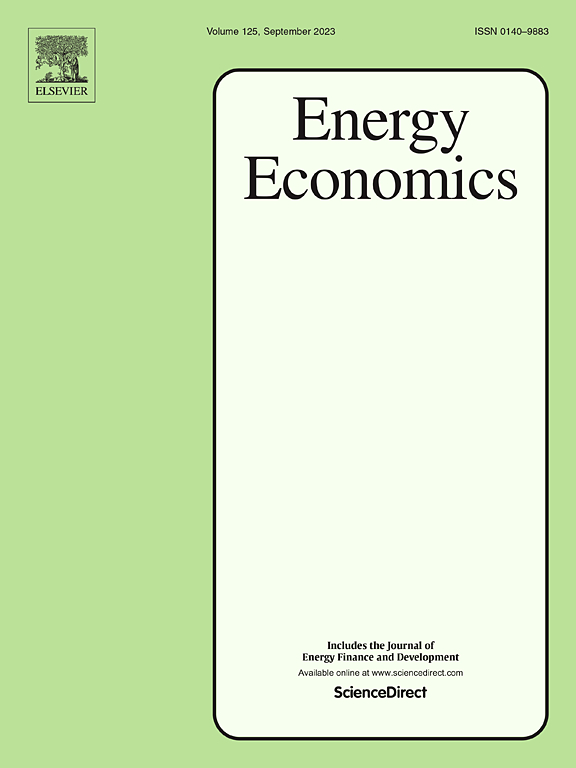主动的电力传输规划能否经济有效地减少碳排放?一个北美西部的案例研究
IF 14.2
2区 经济学
Q1 ECONOMICS
引用次数: 0
摘要
输电投资被认为对电力系统脱碳至关重要,同时,积极的电网规划可以帮助缓解电力市场(如市场力量)的市场失灵。在本文中,我们通过探索输电规划在多大程度上能够主动和经济有效地减少碳排放,同时考虑到同一区域电力市场中不一致的碳监管制度共存所导致的低效发电投资和运营激励,将这些想法结合在一起。使用双层输电规划模型,我们比较了三种政策情况下两种主动电网规划方案减少碳排放的经济效率(与无输电扩建基准相比):无碳政策;一个区域内多个分管辖区的政策不一致(这里称为“异质分区域政策”);或者一致的全系统碳政策。两种主动规划方案是基于最小化市场成本(即不包括外部性成本的系统成本)的传统的基于协同优化的规划方案,以及一种可持续规划方案,其中电网规划者考虑全系统的碳排放损害成本,即使发电公司可能不受任何或异构次区域碳定价政策的约束。在双层模型中,上层的输电计划者决定电网增强的位置和容量,而下层的发电机、运营商和负载服务实体则做出发电扩展和调度决策。基于对北美西部电力系统简化的3节点案例研究和现实的300总线案例研究的见解,我们发现传统的基于协同优化的电网规划可以产生一些经济有效的二氧化碳减排,特别是在缺乏全系统碳定价政策和可再生能源投资组合标准(RPS)政策的情况下。但是,当考虑RPS和更清洁的资源组合时,由于政策的区域异质性,传统的电网规划可能提供很少或没有排放效益。另一方面,当考虑到足够高的碳损害成本值时,在可持续的主动规划框架中核算排放可以以合理的成本提供额外的减排效益。本文章由计算机程序翻译,如有差异,请以英文原文为准。
Can proactive electric transmission planning cost-effectively mitigate carbon emissions? A Western North America case study
Investment in transmission is recognized as essential to power system decarbonization, and at the same time it has been established that proactive grid planning can help mitigate market failures in electricity markets such as market power. In this paper, we bring these ideas together by exploring the extent to which transmission planning can proactively and cost-effectively reduce carbon emissions, while accounting for inefficient generation investment and operating incentives caused by the coexistence of inconsistent carbon regulation regimes within the same regional power market. Using a bilevel transmission planning model, we compare the economic efficiency of two proactive grid planning schemes to reduce carbon emissions (in comparison with a no-transmission-expansion benchmark) under three policy cases: no carbon policy; multiple sub-jurisdictions in a region with inconsistent policies (here called “heterogeneous subregional policies”); or consistent system-wide carbon policies. The two proactive planning schemes are a traditional co-optimization-based planning scheme based on minimizing in-market costs (i.e., system costs excluding costs of externalities), and a sustainable planning scheme where the grid planner accounts for system-wide carbon emission damage costs even though generation companies may be subject to no or heterogeneous subregional carbon pricing policies. In the bilevel model, the transmission planner at the upper level decides on locations and capacity of grid enhancements, whereas the generators, operators, and load-serving entities make generation expansion and dispatch decisions at the lower level. Based on the insights from both a simplified 3-node case study and a realistic 300-bus case study for the power system of western North America, we find that traditional co-optimization-based grid planning can yield some economically efficient CO2 emission reductions, especially in the absence of a system-wide carbon pricing policy and Renewable Portfolio Standard (RPS) policies. But when taking RPS into consideration together with a cleaner resource mix, traditional grid planning may provide little or no emission benefits due to the regional heterogeneity of policies. On the other hand, accounting for emissions in a sustainable proactive planning framework can provide additional emission reduction benefits at a reasonable cost when a sufficiently high value of carbon damage cost is considered.
求助全文
通过发布文献求助,成功后即可免费获取论文全文。
去求助
来源期刊

Energy Economics
ECONOMICS-
CiteScore
18.60
自引率
12.50%
发文量
524
期刊介绍:
Energy Economics is a field journal that focuses on energy economics and energy finance. It covers various themes including the exploitation, conversion, and use of energy, markets for energy commodities and derivatives, regulation and taxation, forecasting, environment and climate, international trade, development, and monetary policy. The journal welcomes contributions that utilize diverse methods such as experiments, surveys, econometrics, decomposition, simulation models, equilibrium models, optimization models, and analytical models. It publishes a combination of papers employing different methods to explore a wide range of topics. The journal's replication policy encourages the submission of replication studies, wherein researchers reproduce and extend the key results of original studies while explaining any differences. Energy Economics is indexed and abstracted in several databases including Environmental Abstracts, Fuel and Energy Abstracts, Social Sciences Citation Index, GEOBASE, Social & Behavioral Sciences, Journal of Economic Literature, INSPEC, and more.
 求助内容:
求助内容: 应助结果提醒方式:
应助结果提醒方式:


